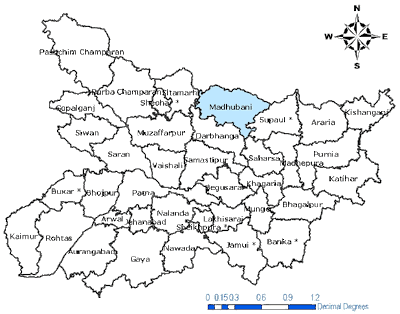Mithila
Painting, Madhubani Bihar
Ardhanarishvara
/ ShivaShakti
The district of Madhubani was
carved out of the old Darbhanga district in the year 1972 as a result of
reorganisation of the districts in the State of Bihar. Madhubani fairly
represents the centre of the territory once known as Mithila and the district
has maintained a distinct individuality of its own. It is said to be that
Madhubani is the world's second city who adapted democracy.
The word "Madhuban"
means "forest of honey" from which Madhubani is derived,
but sometimes it is also known as madhu+vaani, meaning
"sweet","voice/language". Madhubani is the cultural heart
of Mithilanchal, being the birthplace of many literary people and home
to Madhubani Paintings. Maithili has highly developed literature.
Madhubani has produced several authors in different fields. Vidyapati wrote
collection of poems known as "Padabali". Dr. Jaikant Mishra wrote
History of Maithili literature. Mukund Jha Bakshi wrote Mithila Bhasamay
Itihas, a first historical book in Maithili.
Madhubani painting or Mithila
painting is a style of Indian painting, practiced in
the Mithila region of Bihar state,India and the
adjoining parts of Terai in Nepal. Painting is done with
fingers, twigs, brushes, nib-pens, and matchsticks, using natural dyes and
pigments, and is characterized by eye-catching geometrical patterns. There are
paintings for each occasion and festival such as birth, marriage, holi,
surya shasti, kali puja, Upanayanam (sacred thread ceremony),
and durga puja.
Madhubani painting/Mithila
painting has been done traditionally by the women of villages around the
present town of Madhubani and Darbhanga to the west. The painting was
traditionally done on freshly plastered mud walls and floors of huts, but now
they are also done on cloth, handmade paper and canvas. Madhubani
paintings are made from the paste of powdered rice. Madhubani painting has
remained confined to a compact geographical area and the skills have been
passed on through centuries, the content and the style have largely remained
the same. And that is the reason for Madhubani painting being accorded the
coveted GI (Geographical Indication) status. Madhubani paintings also use two
dimensional imagery, and the colors used are derived from
plants. Ochre and lampblack are also used for reddish brown
and black respectively.
Madhubani paintings mostly
depicts human association with nature and the scenes of deity from the ancient
epics. Natural objects like the sun, the moon, and religious plants
like tulsi are also widely painted, along with scenes from the royal
court and social events like weddings. Generally no space is left empty; the
gaps are filled by paintings of flowers, animals, birds, and even geometric
designs. Objects depicted in the walls of kohabar ghar (where newly wed couple
see each other in the first night) are symbols of sexual pleasure and
procreation.
This
painting is, in fact, simplistic manifestation of the philosophical heights
achieved by Indian civilization for the universal power of love, longing and
peace.
The synergy of love and the supernatural generates power of unimaginable intensity and scope: power to play, not control, to dissolve, not dominate, to enhance and enchant, not seduce, to teach and inspire, not deceive, to direct, not manipulate.
The synergy of love and the supernatural generates power of unimaginable intensity and scope: power to play, not control, to dissolve, not dominate, to enhance and enchant, not seduce, to teach and inspire, not deceive, to direct, not manipulate.


























